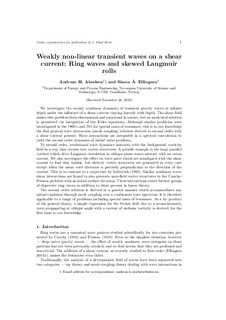| dc.contributor.author | Akselsen, Andreas Holm | |
| dc.contributor.author | Ellingsen, Simen Andreas Ådnøy | |
| dc.date.accessioned | 2019-05-22T05:52:35Z | |
| dc.date.available | 2019-05-22T05:52:35Z | |
| dc.date.created | 2019-02-01T12:26:29Z | |
| dc.date.issued | 2019 | |
| dc.identifier.citation | Journal of Fluid Mechanics. 2019, 863 114-149. | nb_NO |
| dc.identifier.issn | 0022-1120 | |
| dc.identifier.uri | http://hdl.handle.net/11250/2598366 | |
| dc.description.abstract | We investigate the weakly nonlinear dynamics of transient gravity waves at infinite depth under the influence of a shear current varying linearly with depth. The shear field makes this problem three-dimensional and rotational in nature, but an analytical solution is permitted via integration of the Euler equations. Although similar problems were investigated in the 1960s and 70s for special cases of resonance, this is to our knowledge the first general wave interaction (mode coupling) solution derived to second order with a shear current present. Wave interactions are integrable in a spectral convolution to yield the second-order dynamics of initial value problems. To second order, irrotational wave dynamics interacts with the background vorticity field in a way that creates new vortex structures. A notable example is the large parallel vortices which drive Langmuir circulation as oblique plane waves interact with an ocean current. We also investigate the effect on wave pairs which are misaligned with the shear current to find that similar, but skewed, vortex structures are generated in every case except when the mean wave direction is precisely perpendicular to the direction of the current. This is in contrast to a conjecture by Leibovich (Annu. Rev. Fluid Mech., vol. 15, 1983, pp. 391–427). Similar nonlinear wave–shear interactions are found to also generate near-field vortex structures in the Cauchy–Poisson problem with an initial surface elevation. These interactions create further groups of dispersive ring waves in addition to those present in linear theory. The second-order solution is derived in a general manner which accommodates any initial condition through mode coupling over a continuous wave spectrum. It is therefore applicable to a range of problems including special cases of resonance. As a by-product of the general theory, a simple expression for the Stokes drift due to a monochromatic wave propagating at oblique angle with a current of uniform vorticity is derived, for the first time to our knowledge. | nb_NO |
| dc.language.iso | eng | nb_NO |
| dc.publisher | Cambridge University Press | nb_NO |
| dc.title | Weakly nonlinear transient waves on a shear current: ring waves and skewed Langmuir rolls | nb_NO |
| dc.type | Journal article | nb_NO |
| dc.type | Peer reviewed | nb_NO |
| dc.description.version | acceptedVersion | nb_NO |
| dc.source.pagenumber | 114-149 | nb_NO |
| dc.source.volume | 863 | nb_NO |
| dc.source.journal | Journal of Fluid Mechanics | nb_NO |
| dc.identifier.doi | 10.1017/jfm.2018.960 | |
| dc.identifier.cristin | 1672032 | |
| dc.description.localcode | © 2019. This is the authors' accepted and refereed manuscript to the article. The final authenticated version is available online at: https://doi.org/10.1017/jfm.2018.960 | nb_NO |
| cristin.unitcode | 194,64,25,0 | |
| cristin.unitname | Institutt for energi- og prosessteknikk | |
| cristin.ispublished | true | |
| cristin.fulltext | postprint | |
| cristin.qualitycode | 2 | |
